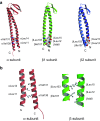Prefoldin, a jellyfish-like molecular chaperone: functional cooperation with a group II chaperonin and beyond
- PMID: 29427249
- PMCID: PMC5899742
- DOI: 10.1007/s12551-018-0400-0
Prefoldin, a jellyfish-like molecular chaperone: functional cooperation with a group II chaperonin and beyond
Abstract
Prefoldin is a hexameric molecular chaperone found in the cytosol of archaea and eukaryotes. Its hexameric complex is built from two related classes of subunits and has the appearance of a jellyfish: its body consists of a double beta-barrel assembly with six long tentacle-like coiled coils protruding from it. Using the tentacles, prefoldin captures an unfolded protein substrate and transfers it to a group II chaperonin. The prefoldin-group II chaperonin system is thought to be important for the folding of newly synthesized proteins and for their maintenance, or proteostasis, in the cytosol. Based on structural information of archaeal prefoldins, the mechanisms of substrate recognition and prefoldin-chaperonin cooperation have been investigated. In contrast, the role and mechanism of eukaryotic PFDs remain unknown. Recent studies have shown that prefoldin plays an important role in proteostasis and is involved in various diseases. In this paper, we review a series of studies on the molecular mechanisms of archaeal prefoldins and introduce recent findings about eukaryotic prefoldin.
Keywords: Chaperonin; Molecular chaperone; Prefoldin.
Conflict of interest statement
Conflict of interest
Muhamad Sahlan declares that he has no conflict of interest. Tamotsu Zako declares that he has no conflict of interest. Masafumi Yohda declares that he has no conflict of interest.
Ethical approval
This article does not contain any studies with human participants or animals performed by any of the authors.
Figures




References
-
- Fujiwara S, Aki R, Yoshida M, Higashibata H, Imanaka T, Fukuda W. Expression profiles and physiological roles of two types of molecular chaperonins from the hyperthermophilic archaeon Thermococcus kodakarensis. Appl Environ Microbiol. 2008;74:7306–7312. doi: 10.1128/AEM.01245-08. - DOI - PMC - PubMed
Publication types
LinkOut - more resources
Full Text Sources
Other Literature Sources

